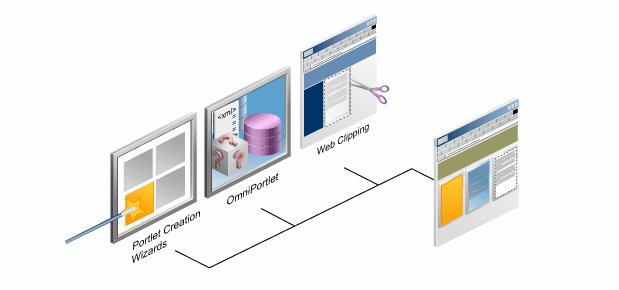
Build Standards-Based Portlets Against a Variety of Sources
Oracle
WebCenter Framework includes the following features that you can use to
create standards-based portlets against a variety of data sources:
- Portlet Creation Wizards: Assist in building JSR
168 and PDK-Java (Portlet Development Framework for Oracle Portal) portlets
quickly and easily.
- JSR 168 Portlets: Standardize pluggable portal components
so that they are independent of the actual portal server for which they
are written. For this reason, you can reuse portlets seamlessly between
portals without changing any code.
When deploying JSR 168 portlets to Oracle's portlet container, they are exposed through Web Services for Remote Portlets (WSRP), which is a Web services standard that enables you to plug and play visual, user-facing Web services with portals or other intermediary Web applications. This standard enables you to consume WSRP 1.0 and 2.0-compliant applications so that customers can share portlets between different Oracle portal products such as Oracle WebLogic Portal, Oracle Portal, and Oracle WebCenter Interaction, as well as non-Oracle standards-based portals. Using this technology, you can surface both standard Java Server Faces (JSF) and Oracle ADF Faces (rich client) components as portlets anywhere in your enterprise, such as your Oracle WebCenter, within a partner's instance of an Oracle WebCenter application or portal, or Oracle WebLogic Portal.
- OmniPortlet: Enables business users to easily publish
data from various data sources using a variety of layouts, without needing
to write any code. Using a wizard-based approach, business users can
quickly produce new mashups from all of the standard feeds that developers
produce. Developers can easily build AJAX-based user interfaces and
add them to the wizard for business users to select.
OmniPortlet can be based on almost any kind of data source, such as a Web service, a SQL database, a spreadsheet that contains character-separated values, XML, and even application data from an existing Web page. Out-of-the-box, OmniPortlet provides the most common layouts for portlets: tabular, chart, HTML, parameter form, news, bulleted list, and form. Using OmniPortlet, you can also enable your users to include Google gadgets or RSS feeds on their pages to include any type of Internet content within the context of their portal or application.
- Web Clipping: Includes mashup tools that enable clipping
some or all of a Web page and exposing it within an Oracle WebCenter
application. Developers can use Web Clipping Studio to clip the content,
expose the content within the Web Clipping portlet, and also reuse a
wide range of Web content, including pages written with HTML 4.0.1,
JavaScript, applets, and plug-in enabled content, retrieved through
form submission. Oracle WebCenter Ensemble can be used with Oracle WebCenter
Framework to add portlets, integrate content, and create lightweight
mashups.
- Oracle WebCenter Application Accelerator for .NET: Allows developers and administrators to service-enable new and existing ASP.NET 2.0 applications through the Web Services for Remote Portlets (WSRP) standard. It also provides an API toolkit integrated into Microsoft Visual Studio 2005 template extensions to simplify portlet development for .NET developers.